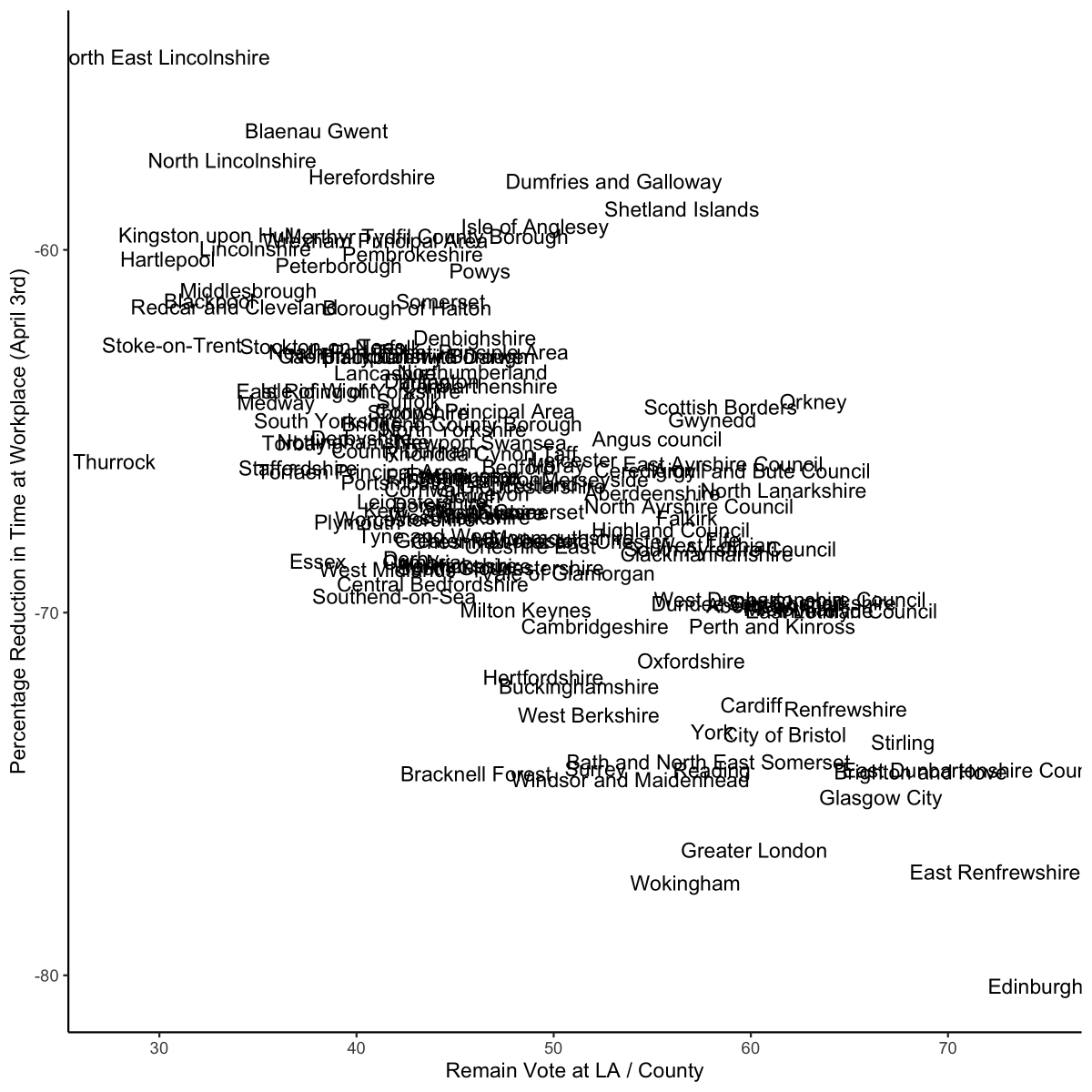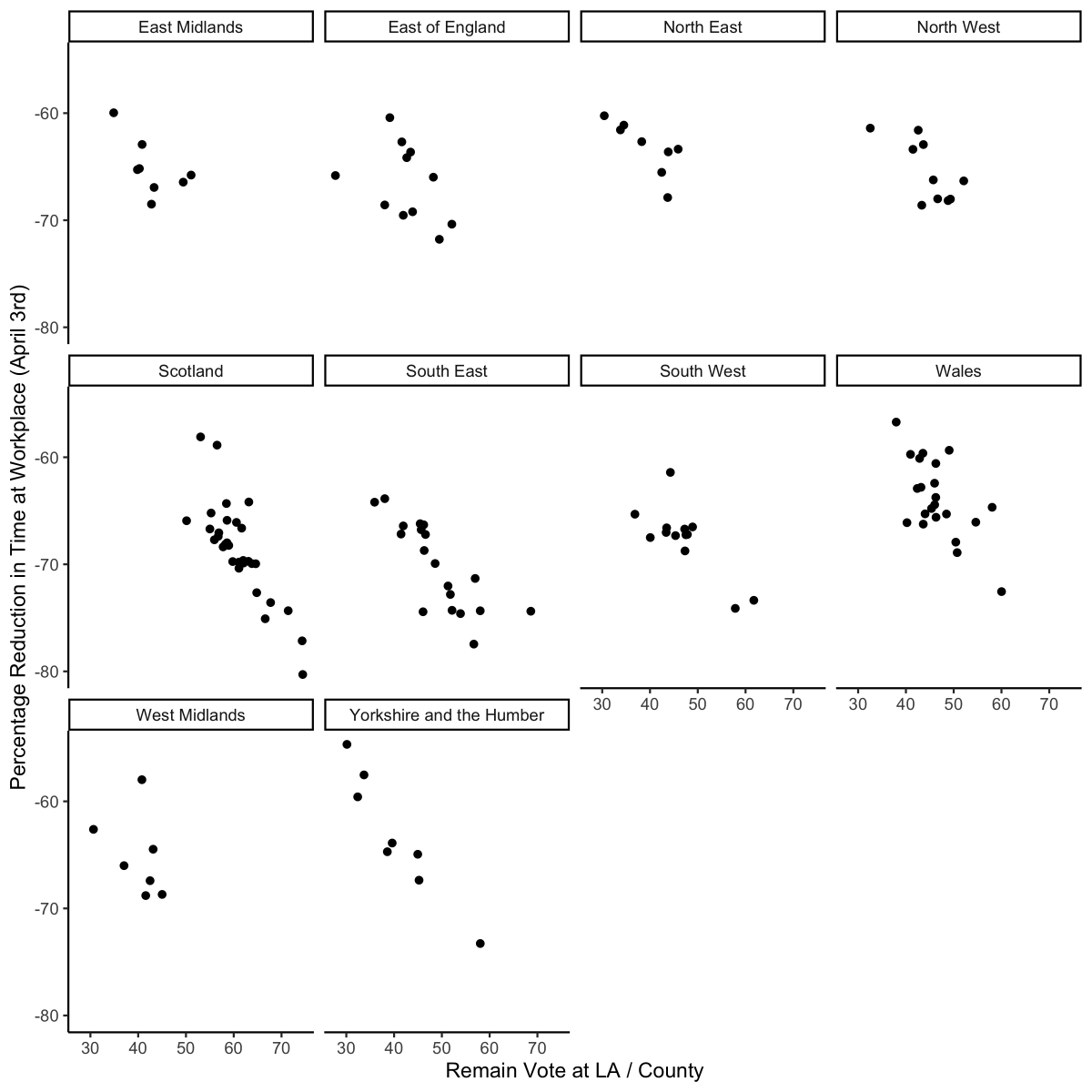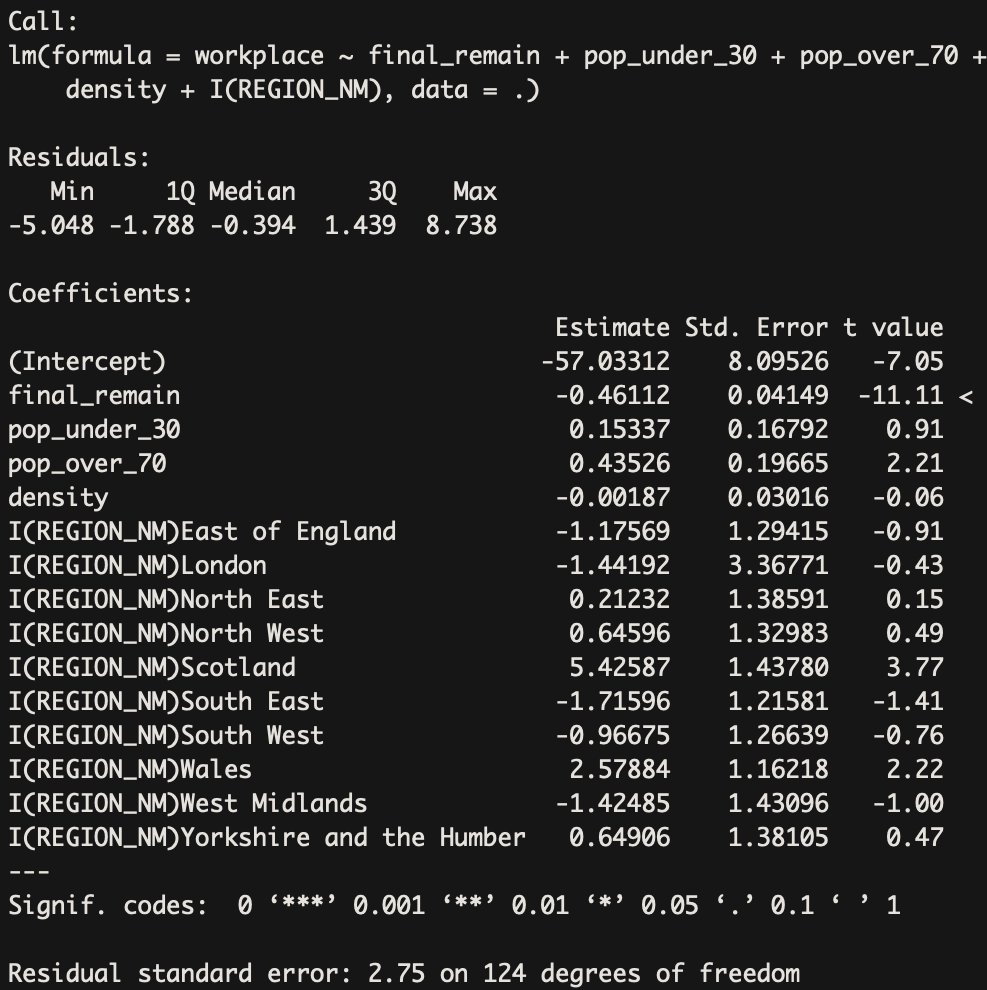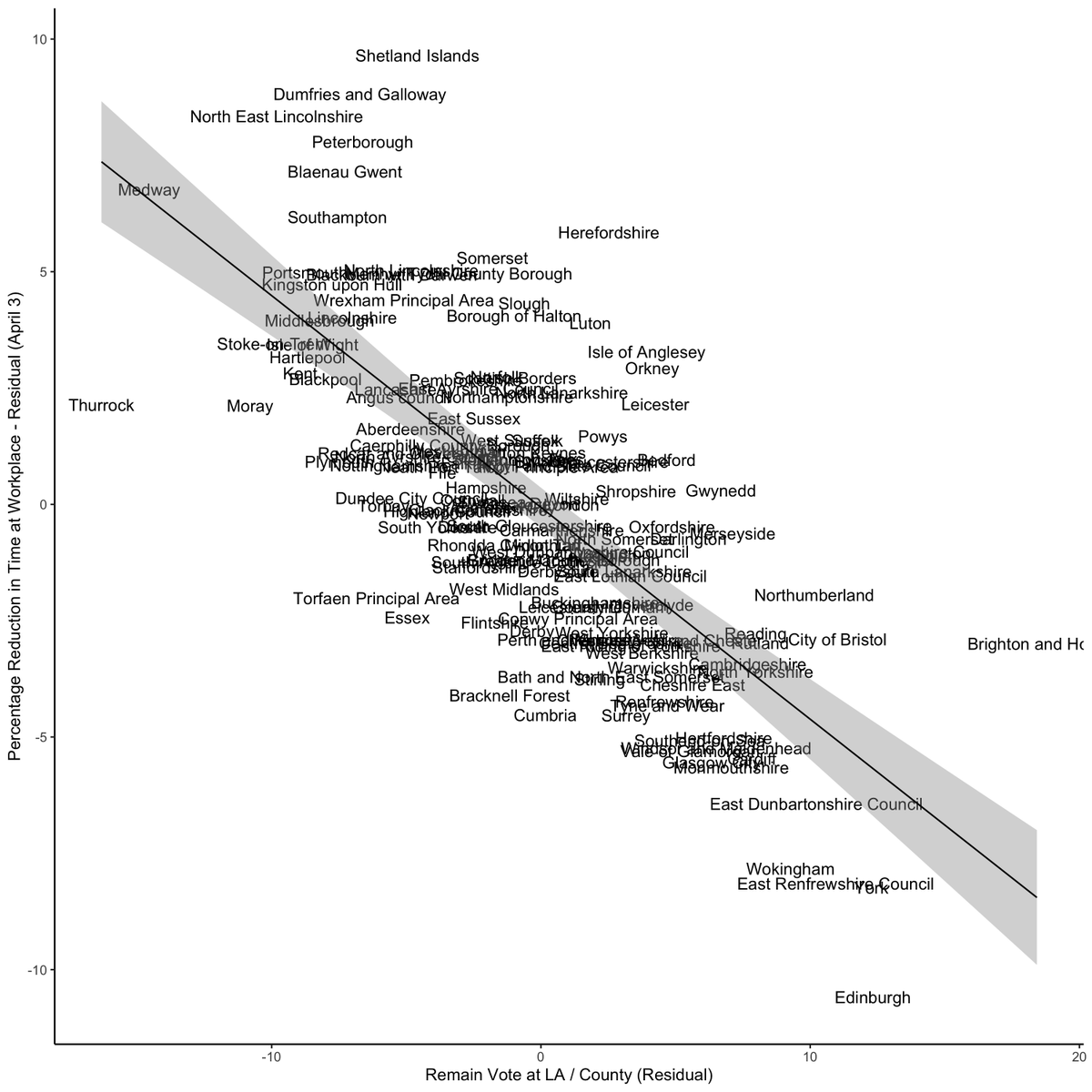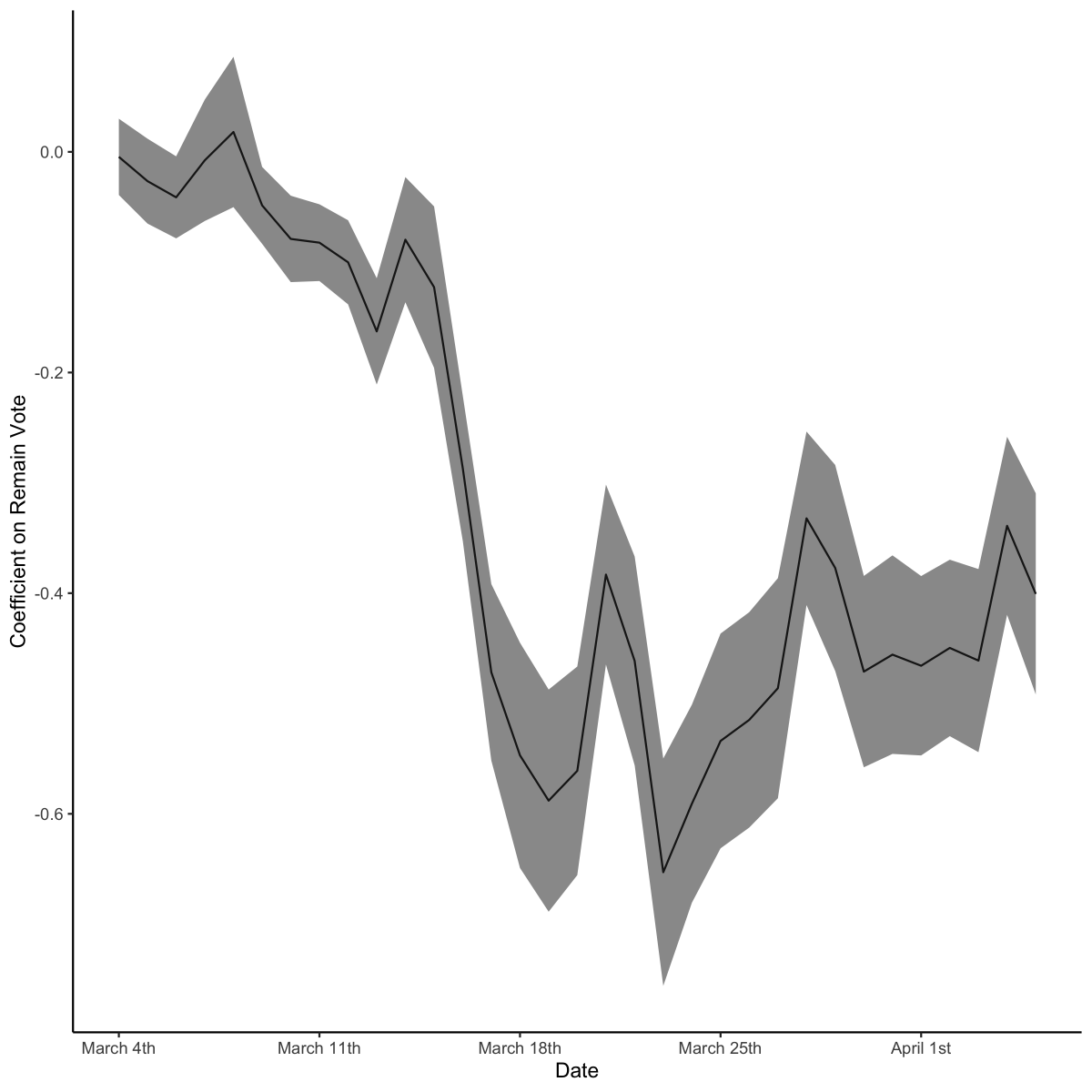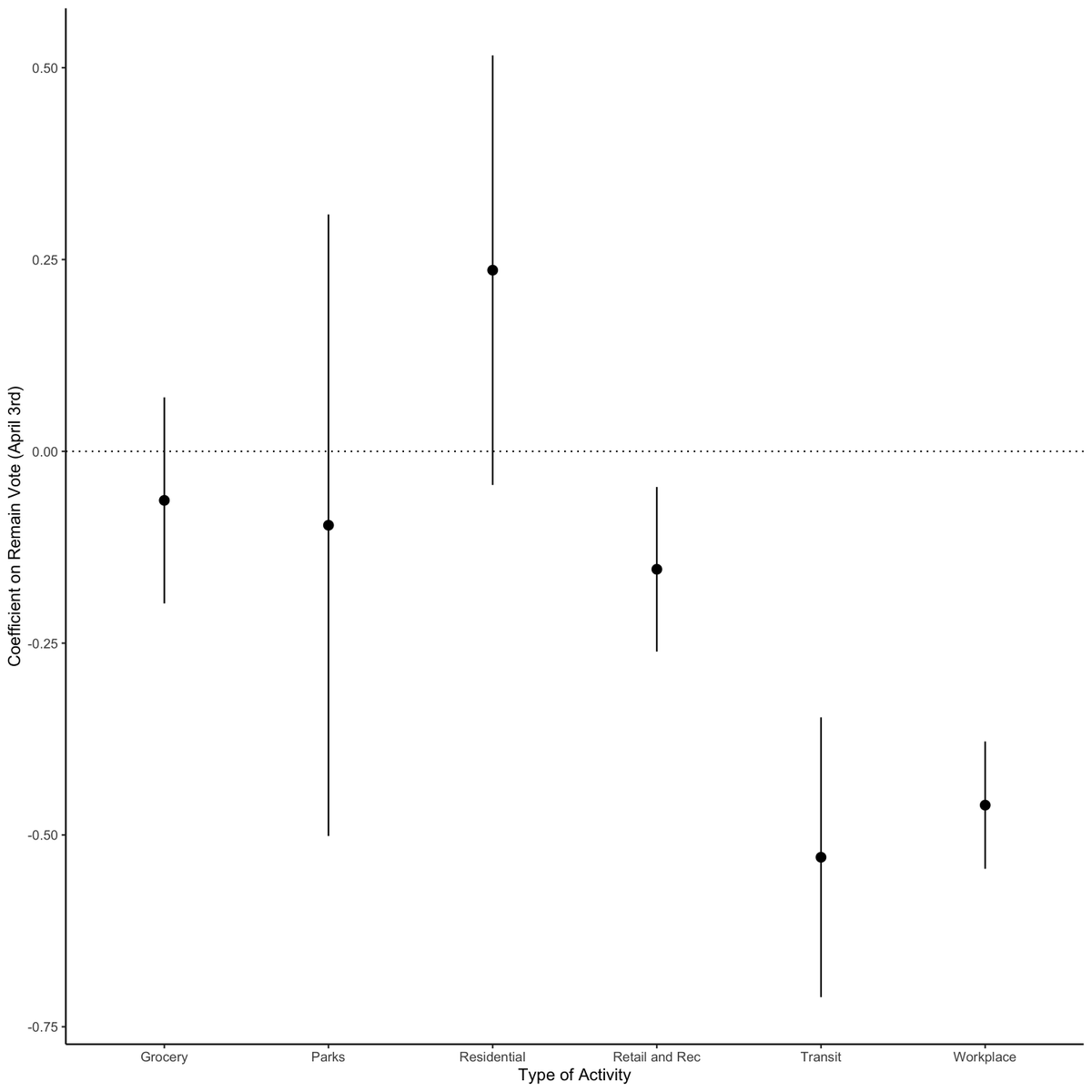The brilliant people at the ONS Data Science Campus have scraped the Google Community Reports and matched them to demographic and regional data. All I have done is further match this to the 2016 referendum vote at the local authority or county level. https://github.com/datasciencecampus/google-mobility-reports-data">https://github.com/datascien... 2/n
Now slightly annoyingly, Google collect activity data at differing levels - sometimes local authority, sometimes county, and just Greater London... But still we can see how demographics and (maybe) politics shape behaviour. And we& #39;ll see the culture war wins out... 3/n
Google collect data on 6 types of activity, taken from people& #39;s mobile phones: activity in groceries, parks, retail, transit, workplaces, and residential. And they are tracking how much lower (or for residential, higher) this is than normal. So those are our outcome variables 4/n
My main focus will be on activity in workplaces since this gives us a good sense of who is still going to work. Now that work might well be essential - so we will look at the others too. But this seems a good place to start. So what explains where has less workplace activity? 5/n
If we just plot the vote for Remain in 2016 against the change in workplace activity by April 3rd (the last day we have full data) we see a strong NEGATIVE relationship. Places that voted Remain are going to work less.
If you look at that figure you will see that while Greater London did indeed vote for Remain and workplace activity has declined strongly there, London is clearly not an outlier. Indeed, because we only have one observation for London, it& #39;s probably underplayed. 7/n
We also see a number of Brexit-friendly places with much lower declines in workplace activity - Lincolnshire, Thurrock, Hartlepool, Hull, Blaneau Gwent. So you might thinki - OK this is just rural areas or old areas where fewer people work so there& #39;s less activity to decline 8/n
I thought that too. So the first thing I did was look to see what the pattern was by region. And Lo and Behold, we see the negative relationship in every region of the country - from Scotland to the South East. So it& #39;s not just rural or more peripheral regions vs London 9/n
OK fine. Maybe it& #39;s driven by the age distribution of local authorities / counties. Or by their density. Seems reasonable. So I ran a simple linear regression with controls for age over 70, age under 30, population density, and a dummy for each region. And you get this... 10/n
Now that& #39;s as ugly as hell and I also don& #39;t really & #39;believe& #39; a t-stat of 11 for the Remain vote. But I guess it shows a very tight fit. And you can see that in this handy partial regression plot I made, which nets out all the demographic, density and regional effects. 11/n
On the partial regression plot you can see places that were *unexpectedly* pro-Brexit given their demographics (Medway, Peterborough, Dumfries) and also unexpectedly & #39;laxer& #39; in terms of stopping their workplace activity. Wokingham, East Dunbartonshire, B & H the oppositive 12/n
So that& #39;s just April 3rd. Is that a weird date? Maybe. The last day in the data is April 5th and it looks similar but has fewer observations. Why don& #39;t we do this same regression analysis for each date since March 3rd? We can see how the estimated & #39;slope& #39; changes over time. 13/n
This figure shows how the negative relationship between an area voting Remain and workplace activity strengthened over time. In the first week of March there& #39;s barely a relationship and people everywhere hadn& #39;t distanced much. But from March 15th to 17th we get a huge drop 14/n
You will recall that is when the government started changing tack rapidly following the Imperial report. And that is when we see this relationship emerge. Everywhere starts distancing but some places more than others. And those places were Remainy areas. 15/n
What about the other five activity indicators? Fear not. Here is the relationship between Remain vote and the change in each activity indicator. We see no effect for groceries or parks. Possibly a positive effect for residential and negative for retail / transit / work 16/n
Do I have a great story for why this happens? Not really. Though transit and work seem closely connected. Residential is of course staying at home but here Google& #39;s data is weaker and lots of regions drop out anyways. 17/n
So, the important part. What& #39;s going on? First off, everything here suffers from ecological inference threats. We don& #39;t know if the type of people who voted Remain and the types of places that voted Remain produce the same effect. It could be Leavers in Brighton distancing! 18/n
We will need surveys to pick this up. But... it is potentially consistent with what American research has shown. This fantastic paper by Allcot et al shows that Republican & #39;areas& #39; were less likely to social distance. 19/n http://web.stanford.edu/~gentzkow/research/social_distancing.pdf">https://web.stanford.edu/~gentzkow...
@TomPepinsky, @ThatSaraGoodman, and @sgadarian show in another great paper that Republicans and Democrats seem to be reacting differently in their health behaviours at the individual level in their responses to COVID. 20/n https://papers.ssrn.com/sol3/papers.cfm?abstract_id=3562796">https://papers.ssrn.com/sol3/pape...
But to my knowledge we have not really see major partisan divides in the UK in terms of social distancing behaviour in the various surveys that have been out in the field. And I don& #39;t recall seeing a Leave / Remain voter split either. 21/n
That could be because British voters trust scientists more, partisanship is less pervasive, Boris is more liked than Trump, etc. But what I showed here in terms of actual differences in regional behaviour suggests that Britain& #39;s & #39;real& #39; divide - Brexit - may really matter 22/n
What do we need to say more? a) Survey data; b) some actual theory about *why* the Brexit divide might be reflected in attitudes towards social distancing (you& #39;ll note I have provided no such theory), and (c) more disaggregated data (come on Google, split up London!). 23/n
What I am willing to say is that I& #39;d be surprised if the underlying cultural / economic divides that shaped Brexit had NO impact on people& #39;s behaviour in the biggest peacetime crisis in British history. COVID will bridge some political divides but not all and not just yet. 24/n
For those interested in the data, I& #39;ll put it up on my Github tomorrow. https://github.com/benwansell/
In">https://github.com/benwansel... the meantime of interest perhaps to @jburnmurdoch @drjennings @robfordmancs @ThatSaraGoodman @sarahobolt @CatherineDVries @davidrkadler @leonardocarella @simonjhix @TomPepinsky
In">https://github.com/benwansel... the meantime of interest perhaps to @jburnmurdoch @drjennings @robfordmancs @ThatSaraGoodman @sarahobolt @CatherineDVries @davidrkadler @leonardocarella @simonjhix @TomPepinsky
Code and data are now up at https://github.com/benwansell/COVID-activity/.">https://github.com/benwansel... Knock yourselves out.

 Read on Twitter
Read on Twitter